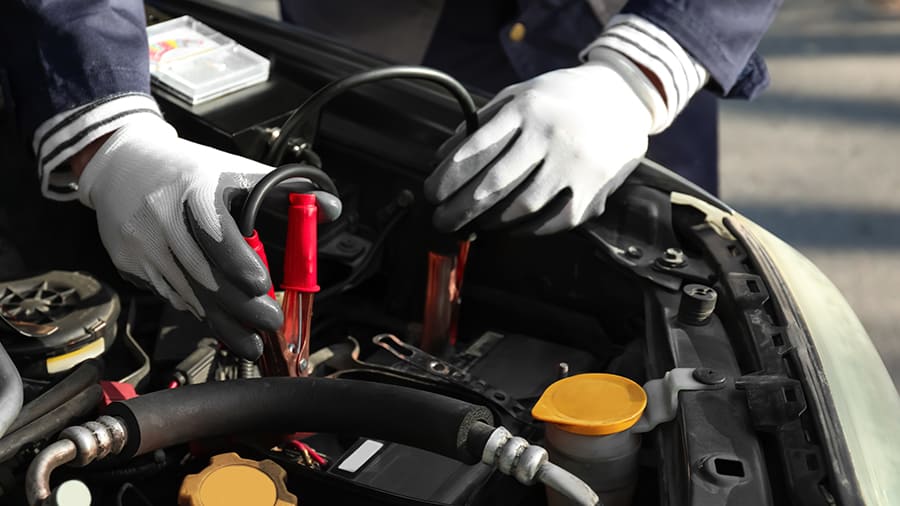Car Clicking When Trying to Start
Learn what that clicking sound means when you try to start your car and how to fix the problem.

Modern vehicles rely heavily on electrical systems for everything from starting the engine to powering accessories. Understanding how to diagnose electrical problems can save you time and money while keeping you from being stranded.
Your vehicle's electrical system consists of three main components working together: the battery, alternator, and starter motor. The battery stores electrical energy and provides power when the engine is off or during starting. It's essentially a chemical storage device that converts chemical energy into electrical current through lead-acid reactions. A healthy 12-volt battery actually measures 12.6-12.8 volts when fully charged and at rest, with each of its six cells producing approximately 2.1 volts.
The alternator acts as your car's power generator, converting mechanical energy from the engine into electrical energy to recharge the battery and power all electrical accessories while the engine runs. It produces alternating current (AC) that's converted to direct current (DC) through a diode bridge, typically outputting 13.8-14.4 volts to keep the battery charged and supply power to lights, radio, fuel pump, ignition system, and computer modules. The voltage regulator inside the alternator maintains consistent output regardless of engine speed or electrical load.
The starter motor is a powerful electric motor that draws 100-200 amps to spin the engine's crankshaft during starting. It engages with the flywheel through a small gear called the bendix drive, which meshes with the flywheel's ring gear to crank the engine until combustion begins. The starter solenoid is an electromagnetic switch that performs two functions: it slides the bendix gear forward to engage the flywheel, and it completes the high-current circuit that powers the starter motor. Understanding this three-component relationship is essential for diagnosing starting and charging problems.
| Symptom | Most Likely Cause | Urgency | First Step |
|---|---|---|---|
| Rapid clicking when starting | Weak/dead battery | Medium | Test battery voltage (should be 12.6V) |
| Single loud click when starting | Failed starter motor | High | Try jump start, check connections |
| Lights dim at idle, brighten with RPM | Weak alternator | Medium | Test alternator output (13.8-14.4V) |
| Battery dies overnight | Parasitic drain | Medium | Check for accessories left on |
| Battery warning light on | Alternator not charging | Critical | Get to shop ASAP (30-60 min on battery) |
| Flickering dashboard lights | Loose connection/bad ground | Medium | Check battery terminals, ground straps |
| Corroded battery terminals | Normal aging/acid vapor | Low | Clean with baking soda & wire brush |
| No crank, no click, no lights | Completely dead battery | High | Jump start, then drive to charge |
Electrical problems often announce themselves through specific symptoms that point directly to the failing component. Clicking sounds when you turn the key indicate insufficient current flow to power the starter motor. This typically means a weak or dead battery, corroded battery terminals creating high resistance, or a failed starter motor. Rapid clicking (multiple clicks per second) specifically points to voltage collapse under load, confirming a battery that can't sustain cranking amperage even if it shows adequate resting voltage.
Dimming headlights reveal charging system problems. If lights dim at idle but brighten when you rev the engine, your alternator is weak and can't produce sufficient current at low RPM-this often indicates worn alternator brushes or a failing voltage regulator. Lights that remain dim regardless of engine speed suggest a severely undercharging alternator or loose alternator drive belt. Conversely, if your battery repeatedly dies overnight or after the car sits for a few days, you likely have a parasitic drain. Something is drawing power when the car is off, such as a glove box light staying on, aftermarket accessories not shutting down properly, or a computer module failing to enter sleep mode.
Dashboard warning lights provide crucial diagnostic information. The battery warning light (often shaped like a battery) illuminates when the alternator isn't charging properly. This means you're running on battery power alone, and you have perhaps 30-60 minutes before the battery depletes completely. The check engine light can indicate electrical problems affecting sensors, ignition components, or emissions systems. Flickering dashboard lights or instruments that cut in and out suggest loose connections, failing ground straps, or poor battery terminal connections creating intermittent contact.
A digital multimeter is your most important electrical diagnostic tool, costing just $20-40 for a quality unit. It measures voltage (how much electrical pressure exists), amperage (how much current flows), and resistance (how much a component restricts current flow). To test battery voltage, set the multimeter to DC volts, connect the red probe to the positive terminal and black probe to the negative terminal, and read the display. A fully charged battery shows 12.6-12.8 volts at rest. Below 12.4 volts indicates a discharged battery needing recharge. Below 12.0 volts means the battery is critically low and may have been damaged by deep discharge.
Test lights are simple but effective tools for checking whether circuits have power. They consist of a probe, a light bulb, and a ground clip. Connect the ground clip to a metal part of the engine or chassis, touch the probe to the circuit you're testing, and if the light illuminates, power is present. Test lights work well for checking fuses, verifying power at connectors, and tracing circuits, but they can't measure voltage levels. They only indicate presence or absence of power. For this reason, multimeters provide more detailed information and are generally more useful for serious diagnostics.
Battery load testers apply a heavy electrical load to the battery while measuring voltage under stress. Most auto parts stores perform free battery testing with professional load testers that apply half the battery's cold cranking amp (CCA) rating for 15 seconds while monitoring voltage. A healthy battery maintains at least 9.6 volts under this heavy load. Batteries that fail load testing should be replaced even if they show good resting voltage, because they lack the capacity to supply cranking current when you need to start the engine. This test reveals weak or failing batteries that might otherwise seem fine based on voltage measurement alone.
Working with automotive electrical systems requires careful safety practices to prevent injury and vehicle damage. Always disconnect the negative battery cable first when working on electrical components. This breaks the circuit and prevents accidental short circuits. Remove the negative cable rather than positive because if your wrench touches metal while removing the negative cable, nothing happens (it's already grounded). But if you remove the positive cable first and your wrench touches metal, you create a massive short circuit with sparks and potential damage. When reconnecting, attach the positive cable first, then the negative.
Never create short circuits by connecting battery positive directly to negative or to ground. This causes hundreds of amps to flow instantly, generating extreme heat that can melt wires, explode the battery, or cause severe burns. Car batteries contain sulfuric acid and produce hydrogen gas during charging. Both are extremely dangerous. Hydrogen is explosive, so never smoke or create sparks near batteries. If acid contacts your skin, flush immediately with water for 15 minutes and seek medical attention. Always wear safety glasses when working with batteries to protect your eyes from acid splashes.
Be cautious with modern vehicles' sensitive electronics. Many cars use complex computer modules that can be damaged by voltage spikes or incorrect jump-starting procedures. Before disconnecting the battery, ensure the ignition is off and no accessories are running. Some vehicles require special procedures after battery disconnection to relearn idle settings or reprogram power windows. Consult your owner's manual before disconnecting the battery on vehicles newer than 2000. When jump-starting, always connect positive to positive and negative to a ground point on the dead car's engine block. Never connect negative directly to the negative battery terminal, as this can cause sparks near the battery where hydrogen gas accumulates.
Many basic electrical repairs are well within DIY capabilities with minimal tools and knowledge. Battery replacement is straightforward. Disconnect negative then positive cables, remove the hold-down bracket, lift out the old battery, clean the battery tray and cable terminals, install the new battery, reconnect positive then negative, and apply terminal protectant. Cleaning corroded battery terminals requires only a wire brush, baking soda solution, and water. Testing battery voltage and alternator output with a multimeter takes minutes and requires no special skills.
Replacing fuses is another simple task perfect for DIYers. Locate your fuse panel (usually under the dashboard or in the engine bay), identify the blown fuse (the metal strip inside is broken or burned), and replace it with a fuse of identical amperage. Never use a higher-amperage fuse. Fuses protect circuits from overheating and causing fires, so using the wrong amperage bypasses this critical safety feature. Replacing light bulbs, installing new wiper blades with integrated electronics, and connecting battery maintainers are all safe and simple electrical tasks.
However, certain electrical work requires professional expertise and equipment. Never attempt to repair or modify airbag systems. These involve explosive charges and specialized diagnostic tools, and incorrect work can cause airbag failure when you need it most or unexpected deployment that causes injury. Similarly, anti-lock brake system (ABS) electronics require professional scan tools and expertise. Hybrid and electric vehicles operate at extremely high voltages (300-600 volts) that can be fatal-only certified technicians with proper safety equipment should work on these systems.
Complex wiring problems, such as tracing shorts in inaccessible harnesses, diagnosing intermittent electrical gremlins, or reprogramming engine control modules, benefit from professional diagnostic equipment and experience. Shops have access to manufacturer-specific scan tools, wiring diagrams, and technical service bulletins that guide proper diagnosis. While labor costs might seem high at $100-150 per hour, professionals can often diagnose issues in 30-60 minutes that might take DIYers days of frustration and guesswork. When electrical problems involve safety systems, complex diagnostics, or high-voltage components, professional service is money well spent.
Most electrical problems are preventable through simple maintenance and awareness. Check battery terminals monthly for corrosion The white, blue-green, or brown crusty buildup that forms where acid vapors react with metal. Clean terminals before corrosion becomes severe using a wire brush and baking soda solution (baking soda neutralizes acid). Ensure connections are tight. Loose battery cables create high resistance that prevents proper starting and charging. Apply dielectric grease or petroleum jelly to clean terminals to prevent future corrosion.
Have your battery tested annually, especially before winter when cold temperatures reduce battery capacity by 30-50%. Most auto parts stores provide free battery testing that measures both voltage and cold cranking amps under load. Replace batteries proactively at 3-5 years of age depending on climate-batteries in hot climates fail faster due to accelerated chemical degradation. Likewise, have the alternator tested annually to catch declining output before you're stranded with a dead battery. Alternator testing measures output voltage and amperage under various loads to verify it meets specifications.
Address electrical issues promptly before they escalate. A weak battery forces the alternator to work harder, potentially shortening its life. A failing alternator discharges the battery repeatedly, damaging the battery through deep discharge cycles. Corroded connections create resistance that generates heat, eventually melting insulation or causing fires. Small electrical problems rarely fix themselves. They progressively worsen until failure occurs at the most inconvenient time. Catching and resolving electrical issues early saves money and prevents the safety risk and inconvenience of unexpected breakdowns.

Learn what that clicking sound means when you try to start your car and how to fix the problem.

Discover why your car's battery keeps dying and learn practical tips to prevent it from happening again.